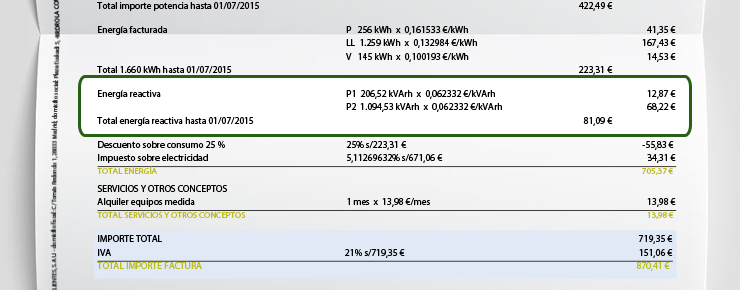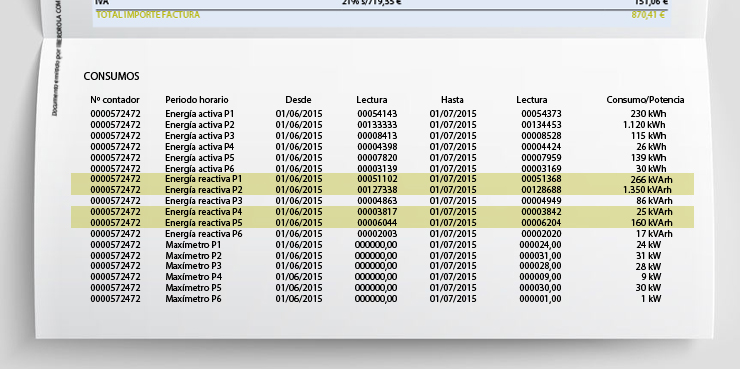




Reactive Energy
Offset its cost in your electricity bill
What is reactive power?
The electricity that you receive and consume every day comprises two sorts of power: active power and reactive power. When added together, the result is known apparent power.
- Active
- +
- Reactive
- =
- Apparent
power
Active power is measured in kWh and is the result of transforming electricity into work and heat.
Reactive power is measured in units of kVArh and is generated by the operation of certain electrical devices which use windings that transform energy into electromagnetic fields (engines, transformers, etc.).
Is the cost of reactive power included in my bill?
It is only included in the bill when reactive power consumption is significant (section 9.3 of RD 1164/2001, dated 26 October [PDF]) and it is applied based on the contracted power:
- Below
15kW Rates 2.0A - 2.1A Billed solely when reactive power exceeds 50% of the active power consumption. - Over
15kW Rates 3.0A - 3.1A y 6.x Billed solely when reactive power exceeds 33% of the active power. It is not applied in the off-peak period (P3 of rate 3.X and P6 of rate 6.X).
You can calculate the consumption of reactive power by multiplying the excess reactive power by the Regulated Reactive Power Charge, which is defined in ITC/688/2011, dated 30 June [PDF].

Reactive power excess in each period of the access tariff is understood as being over 33% of the active power on record for this same period.
Reactive Power Excess i = RPEi - 0,33 * APi
RPEi: Reactive power on record in the corresponding period
APi: Active power on record in the corresponding period.
i : Access tariff period.
The Regulated Reactive Power Charge (€/kVArh) is defined by the Power factor (cosφ), which measures the amount of reactive power over the total power, and is calculated as follows:

If the cosφ is higher or equal to 0.95, no cost will be applied.
If the cosφ is lower than 0.95 and higher or equal to 0.80, the cost will be €0,041554/kVArh
If the cosφ is lower thab 0.80, the cost will be €0,62332/kVArh

The relation between reactive power and active power can also be calculated as follows:
Cosφ = 0,8 means that reactive power is 75% of the active power.
Cosφ = 0,95 0.95 means that reactive power is 33% of the active power.
The electricity bill displays the reactive power surcharge as follows:

In this example, reactive power excess is billed in two periods:
P1: billing for 206,52 kVArh applying a Cosφ less than 0,80, €0,062332/kVArh
P2: billing for 1.094,53 kVArh applying a Cosφ less than 0,80, €0,062332/kVArh
The calculations were made as follows:

Periods P1 and P2 (workdays) should be added to periods P4 and P5 (weekends), respectively; excluding periods P3 and P6. Thus:
| Period 1 | Period 2 | Period 3 | Total Surcharge |
|
|---|---|---|---|---|
| Active Power (kWh) | 256,00 | 1,259,00 | 145,00 | |
| Reactive Power (kVArh) | 291,00 | 1,510,00 | 103,00 | |
| Reactive power excluded from billing (*) (kVArh) | 84,48 | 415,47 | N/A | |
| Reactive Power NOT excluded from billing (en kVArh) | 206,52 | 1,094,53 | N/A | |
| cosφ | 0,66 | 0,64 | ||
| Reactive power billing charge (in €/kVArh) | 0,062332 | 0,062332 | ||
| Charge on the bill: Reactive power billing charge x Reactive power NOT excluded from billing | 12,87 | 68,22 | 81,09 |
(*) After which it is considered as excess (i.e., Cosφ < 0,95 = 33% of Active Power)
How can I eliminate the reactive power billing?

If you install capacitor banks you can eliminate the reactive power penalty on your bill as such banks reduce the demand for reactive power from the grid.
Further benefits afforded by capacitor banks:
- They cut down on Joule effect losses (heating) in conductors and transformers located "upstream" from the capacitor banks, resulting in improved energy efficiency of the electrical system.
- When installed in facilities with power transformers (high-voltage clients), they increase the power available in the secondary.
Iberdrola provides a turnkey installation service for these banks so that the customer does not have to worry about anything.